Marine month continues with the Naked Scientists as we move out from the beach to the coastal waters in search of the world's biggest fish and the corals that glow in the dark to survive. Plus, in the news this week a new personalised cancer vaccine, how to programme human morals into self-driving cars and we investigate the science at work on the courts of Wimbledon...
In this episode
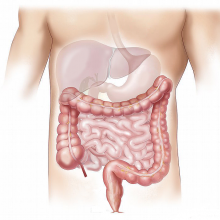
00:49 - Growing replacement bile ducts
Growing replacement bile ducts
with Fotios Sampaziotis, University of Cambridge
Scientists in Cambridge have developed a new technique to grow replacement bile ducts for patients with liver disease. Some children are born with a defective or blocked bile duct, and some adults develop diseases affecting the bile duct system later in life. In both cases the results can be lethal, or require a transplant, if the condition isn't treated. Fotios Sampaziotis, who's a liver specialist at Addenbrooke's Hospital, took Chris Smith through what he and his colleagues have discovered...
Fotios - To give you an idea of what the bile ducts are, the bile ducts form a network of tubes in the liver. Their purpose is to transfer bile, which is a toxic product of liver in metabolism, from the liver to the gut where it helps with digestion. It’s a waste disposal system, effectively, and a waste disposal system doesn’t sound very important, but you can imagine what happens when that waste disposal system breaks down. So the toxic bile overflows into the liver, damages it to the point where we sometimes have to change the whole liver. All this starts from having a problem or a blockage in one small tube. If we could replace this tube then we could go back and solve a very big problem later on: that of liver transplantation. This is what inspired us to start looking into making a bioengineered - or an artificial - organ incorporating human cells, which is what we did in the lab.
Chris - Talk me through what it looks like in the dish then. So you’d start with a sample of, say, my liver. Take me from there...
Fotios - So we would start with a sample of the tubes of the liver, which is a sample of a bile duct; or we would start with a sample of someone’s gallbladder. The next thing we would do is we would put these cells in a dish and grow them out for a few weeks. What we would see is the cells proliferating and then we end up with a very, very large number of cells. The second important bit is that what we managed to do is get these cells to now grow onto a multitude of materials called scaffolds, and they lend to the cells the structure - the mechanical strength - and properties that they need to move from cells to tissue which you can manipulate, you can suture in place, and most important for us, you can fashion and engineer into an organ...
Chris - Because when you say "structure", it’s one thing having a sheet of cells growing in a dish, but that doesn’t make a tube which could then be implanted somewhere and that’s what you're saying the next step is having got the cells growing is to persuade them to form the right shapes and become something useful.
Fotios - Exactly, and that’s what we did. First, we managed to form a tube with human bile duct cells, which is a bioartificial bile duct.
Chris - How big are these tubes?
Fotios - In the human, a centimetre in diameter. However, what we did is we tried this construct in mice, so we had to make a mouse-sized bile duct and that was less than a millimetre!
Chris - Does it work?
Fotios - Yes, it works! We needed to convince ourselves! What we thought we would do is we would transplant these tubes into animals and then we would do a lot of the tests that we do in patients, that your GP orders - for liver blood tests. We also did some MRI imaging to make sure that the bile duct was actually in the right place and there was bile flowing through it.
Chris - So you actually took the tube that would normally connect the liver to the intestine in these animals and replaced it with one you had made yourself using this new strategy and demonstrated it’s working?
Fotios - Absolutely.
Chris - Goodness! So that’s outside the liver – that tube though but there are lots of these tubes inside the liver tissue itself – aren't there? So that’s presumably a more difficult not to crack – getting inside the liver to help those tubes if they break.
Fotios - I completely agree. This is the next big challenge. Because these tubes are so small and so many, they're not amenable to surgical intervention. You can't cut one out and put another one in - there's just too many. So, in that case, what we think might be extremely useful in the future is to deliver the cells directly into these tubes. We have ways of accessing these tubes and we could potentially inject the cells. That for us is an area of major interest.
Chris - What was the big breakthrough here that meant you were able to do this because growing some cells from bits of the body in a dish is something scientists have been doing for a hundred years? So what was the step change that meant you can now actually get this to turn into something useful?
Fotios - What we did that we think made a difference is we grew these cells in a new culture system – in 3D culture conditions. We embedded them in a drop of gel. What the cells do then is they form small tubular structures. Once you have a tube as opposed to a single sheet of cells, it’s far easier for the cells to roll back to their everyday routine and keep performing their functions. So in other words, the cells will deliver more function. Now that was one of the major problems because as I said, bile is very toxic. If the cell becomes comfortable in the dish and forgets how to fight off the bile and then all of a sudden, you expose it to a highly toxic environment, the cell will probably not have time to readjust and might die. However, if you keep them in an environment where they maintain their function, it’s so much easier to go back to their natural niche; to their natural environment.

06:19 - Programming human morals into driverless cars
Programming human morals into driverless cars
with Peter Cowley, Angel Investor
This week entrepreneur and angel investor Peter Cowley has been looking at a study considering how to programme morals into driverless cars. He explains to Chris Smith what they study sought to discover...
Peter - Yes, a very interesting study by a German academic, published in the Frontiers in Behavioural Neuroscience. But, if you don’t mind, I'm just going to back up slightly first in this car and just mention some of the facts and figures about death on the roads. Unfortunately, worldwide, there are about 1.5 million deaths from the roads a year, but the UK is actually one of the top 5 safest. We still have 1700 deaths a year though. And in many countries somewhere between 70 per cent and 90 per cent are due to human error. The studies have shown that that should drop by at least 90 per cent. So that’s down from 1700 to 170 or so in the UK.
Chris - Why will those lives be saved?
Peter - Those lives will be saved because the accidents wouldn’t happen. So cars will not hit each other, and cars will avoid in most cases – not all cases – hitting another human being out on a bicycle or whatever. So the pros for self-driving vehicles are a huge reduction of CO2 - mainly because the cars will be used 80 per cent of the time rather than 4 per cent of the time - huge financial savings because we won’t all need to own cars, huge amounts of space released for car parks, a great improvement in the ability of elderly, the blind, and disabled to be mobile, which will probably fit in with me because I'm 61 now - and at least it would probably be 10 to 20 years away, and a vast improvement in productivity. The cons are mainly going to be labour losses in the car manufacturers, in repair shops etcetera, and in insurance.
Chris - Now let’s talk then about the question of morals because the one thing you have mentioned is yes, they’ll be a lot safer but this still means that there is a blame game problem because, at the moment, if I get in my car and I have an accident, it’s clear that, if I've caused it, I'm to blame. If the other driver caused it, they're to blame. If you’ve got a computer driving your car, we have a problem!
Peter - That's correct. At some point – there's no doubt whatever – there will be deaths still on the road. At some point, somebody, some system somewhere, written by a human being has got to make a decision about what to hit. Now, in principle, I think it should be argued that the person in the car – the occupant of the car – even though they're not driving is – although maybe not to blame – is the person who possibly should be the most likely to be damaged. Bear in mind that, of course, you're inside a metal box which is very, very safe anyway.
Chris - What did they do in this present study?
Peter - In this study, a hundred or so people were asked to wear a virtual reality headset and they were seeing themselves driving along in a lane with a variety of inanimate objects – animals, humans: so dogs, males, females... and it was foggy. The fog suddenly lifted and they were given between 1 and 4 seconds of time to make a decision about whether to go straight on, or whether veer off. If they went straight on, something would happen. Some people would die, including themselves possibly, and if they veered off, another set of people would die. The result was that the dog was the most valuable animal - more valuable than the cat! - children were more valuable than adults – not surprisingly - and females were very much more valuable than males!
Chris - In other words, the drivers are coming along and they're deciding - in a split-second - “I'm going to save the child to spare the adult...", or, "I'm going to save the female to spare the male...”
Peter - Very, very difficult in the 1 second. How much processing can you do? It’s got to be done on instinct then, hasn’t it? Four seconds: you might have just enough time to process it, but not in 1 second.
Chris - So that’s what a person would do. How do we code that into a computer, or do we want to?
Peter - Exactly. Can we just compare with medical ethics? NICE [the National Institute for Clinical Excellence] has to make decisions as well about whether to save a life or not. That’s done with huge amounts of time and huge amounts of data. In this situation, you’ve got a very short time. Now a computer has got a very much longer time, but it still can't make a decision whether - or should not make a decision - an adult, or maybe an animal, is of less value than a human. But a human is still of the ultimate value.
Chris - What are we actually going to do then, off the back of this study? What are they saying their conclusion is?
Peter - They’ve come up with 20 rules. My German is a bit rusty now - I've left about 35 years ago - but when I flipped through it, the rules basically are that autonomous systems in principle should be adopted if they're going to cause less accidents. That’s almost a given: the people must be protected. A very important one: the state defines the rules, not the technology company, not the car manufacturer. The state will make the rules. The system can distinguish by sex, age, or size, etc., and then there's a number of rules or some guidelines about their security ownership and data logging.
Chris - If you take those guidelines and ask, were those guidelines in place, would the computer be making different decisions with the humans, or the same one?
Peter - Well that’s the big question isn’t it, Chris? It could be done by wishing learning. If there was enough data out there, they could learn and then that would actually adopt the way the humans would behave. But in principle, it’s almost impossible to work out how they can make this decision which is why this has all been brought into the public domain so early to have debates.
Chris - But the thing is, it is really important because when we start making, not one but a million of these electric cars then the software that’s in one will be propagated into a million. And so, the decision that one makes will be the same decision a million makes so we have to get this right.
Peter - Yeah, I think it will because I think the different car manufacturers will have different algorithms. I don’t think there’ll be a global algorithm for this. But you're right. Sometimes needs to be gotten right.
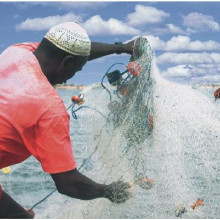
12:16 - Down to Earth: Space lifeline for seafarers
Down to Earth: Space lifeline for seafarers
with Dr Stuart Higgins, Imperial College London
In this week’s Down to Earth, where we take a look at tech intended for space which has since found a new home down here on Earth, physicist Stuart Higgins is hearing how the Indian space programme is throwing seafarers a lifeline…
Stuart - What happens when the science and technology of space comes down to Earth? Welcome to Down to Earth from the Naked Scientists, the mini-series that explores how space tech is used here on Earth. I'm Dr. Stuart Higgins. In this episode, we’re looking at how India’s space programme is helping to save fishermen’s lives. The Indian Space Research Organisation otherwise known as ISRO was formed in 1969. It aims to use space technology for national development as well as scientific research. As part of this mission, ISRO created the Indian National Satellite System – a series of satellites that although being in space are very much pointed back down towards Earth. They house instruments for weather monitoring as well as radio transmitters for telecommunications, TV broadcasts, and also, search and rescue operations. It’s that latter category that led to a space tech spinoff with the stress alert transmitter. It’s an emergency beacon that can be attached to fishing boats and used to contact the coast guard in case of emergencies. While similar systems were already available, the ISRO system took advantage of the Indian National Satellite System to provide continuous coverage for the Indian Ocean. This is because the satellites are placed in a geostationary orbit. (Music) The speed with which a satellite orbits the Earth depends upon its height above the surface. Objects in low earth orbits with few hundred kilometres travel faster than those higher up. This means they orbit the Earth multiple times per day. In a case of an emergency beacon, it’s critical for the distress signal to get through at any time of day, not just when a satellite happens to be orbiting overhead. One way to achieve this is to place the satellite into geostationary orbit which is about 36,000 kilometres above the Earth’s surface. At this orbit, the relative motion of the satellite matches the rotation of the Earth. So the satellite effectively sits by the same point on the equator without changing position. ISRO’s distress alert transmitter uses a combination of the Indian National Satellite System and the Global Positioning System, GPS. So in the event of an emergency on-board a boat, the distress alert transmitter is activated by pressing a button corresponding to the type of emergency. Initially, a GPS receiver determines the boat’s location. This plus the type of emergency is transmitted by a radio up to the Indian National Satellite System. A satellite relays the signal back down to a base station on the mainland, alerting the coast guard. Although simple to use, the distress alert transmitter relies upon some serious space technology to help save lives.
That was Down to Earth from the Naked Scientists and join me again soon to learn about more space technology that’s changing lives back on earth.
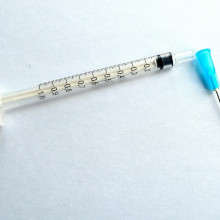
15:28 - Personalised skin cancer vaccine
Personalised skin cancer vaccine
with Catherine Wu, Harvard Medical School
In the last ten years or so the rates of malignant melanoma, which is a form of skin cancer, have doubled. But our ability to cure the disease has remained pretty dismal, with 5-year survival rates down at around 10% for people who present with a cancer that’s already spreading. This week there's some good news though: a pair of papers by researchers in Germany and the US have described techniques for producing personalised anticancer vaccines, which single out chemical differences between a patient's cancer cells and their healthy tissue... and triggers immune T cells to attack exclusively the cancer. It relies on the fact that cancers make a lot of genetic spelling mistakes - called mutations - when they copy their DNA, and this is what introduces the differences recognised by the vaccine. Cathy Wu leads the US team at the Dana Farber Cancer Institute. She explained to Chris Smith what her team have achieved...
Cathy - We were able to take tumour specimens, sequence them to understand what was the entire DNA content of these melanomas, and then using new computer tools predict which of those mutations could potentially be seen by the immune response as tags that mark the cancer as different.
Chris - So, essentially, you are comparing what's normal for that person - from healthy tissue - with what's happened to the genetics of their cancer to see if there are changes there that will be reflected in the way the cell appears on its surface markers that the immune system might be able to spot that will be specific to the cancer and will be absent from a healthy cell in any other part of the body?
Cathy - Exactly. What makes our vaccine different from what has been generated previously is it’s not a one-size-fits-all, but rather that it’s personalised and tailored to the individual cancer that we are studying.
Chris - Roughly, how many markers do you get for each patient?
Cathy - We get hundreds to thousands of mutations, but only a subset of them are going to be displayed in a format that the immune system can see. But even from those, we have several hundred from which we can prioritise and choose. So we selected the top 20 hits that we could predict and that’s what the vaccine is more composed of.
Chris - So having identified these DNA differences, the mutations that single out the tumour compared with a healthy tissue, you then work out what those genes would turn into on the cell surface in terms of these chemical markers and you make an artificial form of those chemical markers which is going to form the basis of your vaccine.
Cathy - Right. So that artificial form is what we call a peptide. It is a string of building blocks of proteins and they have that change generated by the mutation. So if you can imagine that we have up to 20 of these strings of amino acids and we put it into a syringe, and we give it together with an immune stimulant and we do give a series of injections – 5 over the first three weeks and then 2 boosters – the idea is that immune-stimulants sends out the signal for immune cells to come into the vaccine site, gather up those peptides, and then display it to the immune response where a cascade of events then lead to the calling of that army of T cells that might then recognise the patient’s tumour cells.
Chris - How long does it take to make one of these vaccines because one of the things about cancer is people don’t want to hang around, and we know that holding up treatment could actually lead to a disease acceleration or the disease progressing? So how long does it take you to get this ready to go and into a patient for each person?
Cathy - For our study, it required up to 3 months. However, there is no reason this could not be created within 4 to 6 weeks.
Chris - Critically, did it work, Cathy? Did you get T cells capable of combating the tumours in these people? Second question, did those cells actually combat tumours?
Cathy - We have to remember that this was a phase one study. Meaning that this was our first foot out the door and our goals were safety and feasibility. In that, we definitely succeeded. So we were able to show that this whole procedure caused very, very minimal side effects. The other goal that we had was asking: Could they generate a strong immune response? There, we were also very successful. We identified very, very strong immune responses that we could pick up in the blood. Finally, we could demonstrate that those immune responses could clearly not only circulate but also, recognise the patient’s own tumour. The best measure of whether or not we were successful is whether or not the patients did well in the long term. We observed our patients for 2 years or more and they have been without evidence of disease return.
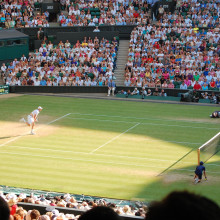
21:04 - The Science of Wimbledon tennis
The Science of Wimbledon tennis
with Tom Crawford and Georgia Mills
Grab your rackets, your strawberries and cream and - as long as you’re old enough - a glass of Pimms; because Wimbledon’s underway… and to celebrate we’re having a rally of our very own!
Female - And it’s a match of the titans today. Georgia Mills and Tom Crawford have come armed with their top tennis facts. It's anyone’s guess who will be crowned champion. It’s you're Quick Fire Science on Wimbledon. And they're off!
Georgia - Once upon a time, tennis rackets were made out of wood which was weak and warped over time. But now, we use carbon fibre set in glue which is high strength and low weight.
Tom - And not all rackets are vegetarian. Some strings are made from cow intestines but most are the polymer nylon.
Georgia - If you hit the ball in a certain way, you create top spin which makes the ball fall sooner than a ball without it. This relies on something called the magnus effect: Whilst the ball is spinning through the air, a thin layer of air around it is also rotating, and the differences in pressure between the air on top and the bottom of the ball creates a force.
Tom - This is what pushes the ball faster towards the ground and is why you have to use top spin with your balls if you want to be too fast for your opponent. Rafael Nadal is one of the best. He could spin a ball at 3,600 rpms.
Georgia - Over the course of Wimbledon, they sell around 320,000 glasses of Pimm’s. If one person managed to drink that and miraculously didn’t die, it would take around 36 years to sober up. Cheers!
Tom - Wimbledon is one of the very few tournaments that still use grass instead of clay or acrylic. The grass used is perennial ryegrass, scientific name Lolium perenne because of its resistance to wear and impressive regeneration capabilities.
Georgia - Grass courts make it slightly less predictable where the ball is going to bounce but also makes for a faster game. This is because grass as a surface isn’t very even and also has less friction.
Tom - The winner of a coin toss decides if they want the first serve. But the odds aren't exactly 50/50. Coins have a 51 per cent chance of landing on the side that was faced down at the start.
Georgia - Plus, some statistics have shown a very small advantage to being the first serve on the first set although this effect does seem to disappear if the players are very evenly matched.
Tom - It’s not just balls that are served. Over 28,000 kilograms of strawberries are consumed by hungry punters. That’s the equivalent weight of 4 African elephants. Luckily, there's 10,000 litres of cream on hand to go with them.
Georgia - The ball’s yellow colour may be iconic, but Wimbledon used traditional white balls until 1986. The yellow ball first started being used when research showed that they showed up better on television.
Tom - Each tennis ball is hollow and is filled with a gas which is usually nitrogen that’s held at a pressure higher than the air outside. This means that over time, the gas leaks out which is why the balls need to be replaced.
Georgia - This is why when you open a new can of balls, you get that lovely popping sound as the cans are pressurised to keep the balls in tiptop condition. It’s also why you'll often see the players squeezing their balls on the pitch to see if the pressure is good enough.
Female - Game, set, match. What a game ladies and gentlemen, what a game!
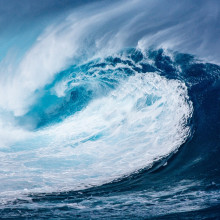
25:09 - Making waves
Making waves
with Megan Davies Wykes, University of Cambridge
Before we go under the water, we’re taking a look at what goes on on the surface. Waves are ubiquitous in the marine world. But how do we study them and why do they matter? Tom Crawford went along to Cambridge University’s Maths department to meet researcher Megan Davies Wykes...
Megan - This is what we call the solitary wave tank. So it’s a very long tank that we use to produce waves.
Tom - Along the line, it looks like about a 10-metre long fish tank to me.
Megan - It’s pretty accurate.
Tom - It seems to be filled about mid-depth, so maybe 30, 40 centimetres of water. Is this freshwater or salt water?
Megan - This is just normal tap water.
Tom - Okay, great. How are we going to be generating waves? At the moment, it all looks very still and nice, and very tranquil.
Megan - So I've got a paddle here. If I move the paddle backwards and forwards, it creates waves in my tank that have various frequencies and wavelengths. The wavelength is the distance from the crest to the next crest.
Tom - So when you say wave here, I imagine almost like a squiggly sort of like sign wave.
Megan - Exactly. Like the traditional example is, imagine a wave along a skipping rope.
Tom - And the frequency I'm guessing is how often these waves appear. So that’s going to be to do with how fast we move the paddle.
Megan - Exactly, yeah.
Tom - So the waves this tank can make, are they a particular type of wave?
Megan - So, there's a couple of different types of waves. The ones I'm making right now are deep water waves. They're deep water waves because the depth of the water is quite big compared to the wavelength of the wave. There's another type of wave which is called shallow water waves. They're when the wavelength is quite large compared to the depth of the water. They’re ones you'll see if you're standing on a beach watching the waves come in to shore. When something is quite interesting about shallow water waves is the speed of a shallow water wave depends on the depth. That means that as these waves are coming in towards the shore, a bit of the wave that’s over the shallow bit of the shore goes slower and the bit of the wave that’s over the deeper bit will go faster. So, waves will kind of turn in towards the shore and that’s why when you're standing on a beach looking at the waves washing towards you, they're always coming like straight towards you.
Tom - The big question is Megan, can I have a go?
Megan - Absolutely. If you move it backwards and forwards, making great waves. These waves are actually going all the way down the other end of the tank and splashing onto a sort of beach we have at the other end. So we’re going to do a little experiment. So we’re going to make two strokes of this paddle to make a wave. I'm going to do it twice. So the first time, we need to move it to some set distance and do it quite slowly and in the second time, you're going to move at the same distance but move it a bit faster. I mean, the time, how long it takes to get the wave from one end of the tank to the other.
Tom - So this is two full strokes of the paddle at a slow speed and go… Okay, how long did it take?
Megan - It took 4.5 seconds.
Tom - 4.5 seconds. So it’s 4.5 seconds for our wave to go the full length of the tank. Experiment number two, so I'm doing the same thing. I'm moving the paddle the same distance and you want me to do it faster this time.
Megan - Yeah.
Tom - Right. Ready… Okay, I’d say I moved the paddle almost twice as fast that time, so I'm going to go out a little bit here and make a guess and say it went maybe twice as fast?
Megan - Nope. It went at the same speed.
Tom - So it’s 4.5 seconds again?
Megan - Yeah.
Tom - Okay, you're going to have to explain this one, Megan. What's going on here?
Megan - So what we’re doing in this tank is we’re making deep water waves. And thinking about deep water waves is, the speed is set by the wavelength. So because we moved the paddle the same distance, the wavelength is the same so the speed was the same.
Tom - That was quite a fun experiment. I'm not going to lie. I did enjoy making some waves in this pretty much giant fish tank, but of course, you actually do real scientific research here in the Fluids Lab at Cambridge. Can you tell me what kind of things do you look at?
Megan - Something we were very interested in is mixing in the ocean and there's waves inside the ocean, just like there are waves on top of the ocean, and these waves are called internal waves. These internal waves are really important for what goes on inside the ocean and we’re able to – in this tank – run experiments where we’re able to recreate internal waves just like they appear in the ocean.
Tom - So, it’s a case of – we have data from real internal waves in the ocean, but it’s very hard to obtain, and it’s very hard to measure and study them in the ocean. You know, you have to go out on a boat and what not. So, you're saying, “We take the data that we have and then use it to recreate real world situation in this lovely controlled environment in the lab where we can really study it, and really understand what's happening.”
Megan - Yeah, exactly.
Tom - Why are internal waves important and why do we need to know more about ocean mixing?
Megan - So, if you want to make models of the ocean, you may need to understand how it works and internal waves and mixing are really important to that. If we understand how it works then we can build models of it and understand how things like climate change are going to affect the ocean.
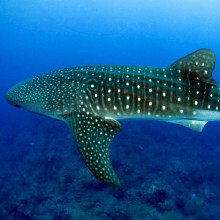
Swimming with whale sharks
with Frank Gagliardi, Ningaloo Whaleshark-n-dive, and Dr Brad Norman, Ecocean
Now it’s time to dive beneath the waves to meet one of the largest animals on Earth. Imagine being in the water alongside a fish the size of a bus and weighing about 10-20 tonnes. Well that’s the experience I had last month when I went to the Ningaloo Reef world heritage site. It’s located off the northwestern coast of Australia and as well as being the country’s largest fringing coral reef - meaning it lies close to the shore - it’s also home to the whale shark. Chris went out on one of the boats run by a local dive company that specialises in taking people “swimming with the big boys”...
Frank - My name is Frank Gaggliardi. My home is here on the Ningaloo Reef and take people swimming with whale sharks. So we’re standing on a fly bridge. So the top part of a 65-foot vessel that’s fully equipped for dive and snorkel operations and we’re currently looking at the 5th day and very lovely customers having a swim on a patch of coral bommies.
Chris - Just another day at the office.
Frank - Yeah, just another day at the office – very, very lucky. Very lucky indeed.
Chris - It is a wonderful place to work. How do you actually do what you do because people are paying your company to find them whale sharks to swim with, but how do you do that?
Frank - We keep it as simple as possible. So we have a charter company, plane company that is in town and we hire our own plane or charter our own plane every day that searches the back of the reef for whale sharks. It’s just one guy in the aircraft and he can get a bit dizzy circling around all day and he’s looking out of the side of the aircraft and he’ll spot them, and then he gives us a bearing so basically just a very rough idea. It’s in your say, 12 o’clock or your 1 o’clock, by about 500 metres to a mile. Once we get close enough to the whale shark then I’ll usually pick him up by sight from the boat and then we can look and stick into our guidelines how he act and drive around the whale shark to disturb them as least as possible.
Brad - I'm Dr. Brad Norman. I'm from a not for profit group called Ecocean, works on whale sharks in Australia and does some work overseas. Whale sharks are a fantastic creature. They're the biggest fish in the sea. They can get up to 18 metres in length but they are a gentle giant. They're a filter feeder. A huge animal, but we get to see them in a natural environment. To see this huge creature that’s of no danger to us, covered in a beautiful pattern of spots that we can get within a few metres while swimming alongside them is truly an amazing experience.
Chris - It is a beautiful pattern they have. Just describe that because I don’t think I can do it justice.
Brad - Yeah, it is beautiful. A shark’s skin is quite a dark colour, sort of a brownie, gluey colour, grey even, but all across the animal is white spots. Some of them are quite small but some of them are the size of a tennis ball. But those spots are sitting in a pattern that’s unique to each individuals, actually like a fingerprint.
Chris - And you can use that to identify them, don’t you?
Brad - Yeah, we do and that’s something that we sort of initiated up here in Ningaloo Reef and now, it’s a global programme where we can actually identify individual animals through the spot pattern and determine whether that same individual is returning on a daily or weekly, monthly basis, or in years to come, or if there's a lot of new individuals coming to Ningaloo Reef every year.
Chris - Do they migrate – these fish – or do you have a population of whale sharks here in this patch Australian coastline that stay here all the time?
Brad - We’ve been able to identify a lot of individual whale sharks from Ningaloo Reef and in fact, some of them have been seen or I photographed them over a 22-year period. So they’ve come back every year or almost every year for that period of time. now it’s a couple of sharks, but there's many sharks that we see on a regular basis, even yearly basis. But there's a lot of new ones that come through and there's a lot of ones that we don’t get to see again. So there's a transient and a resident group of sharks that come to Ningaloo.
Chris - So what is their range globally then?
Brad - Well, they are broadly distributed right around the globe, about 20 to 30 degrees north and 30 degrees south latitude, a sort of in that warm water tropical band, but the sharks are distributed all around the globe. But it’s only been in recent years that hot spots are being found in various parts of the world.
Chris - Is it a coincidence that some of the biggest animals on Earth are the ones that eat the smallest things because you said they're filter feeders? They're filtering out – in some cases – microscopic things to eat.
Brad - Pretty much. They can filter down to literally any couple of millimetres in length in these animals. They’ve got a lot of protein inside these small (33:34) cover part of krill or small crustaceans. They can feed on small fish and larger animals, but they seem to be able to find and target and survive by feeding with the smallest organisms.
Chris - What's the actual practicality of that filter feeding? How do they do it?
Brad - Well basically, there's two ways of doing it. We’re working what we can see. So a lot of the time, the plankton, the zoo plankton comes to the surface an evening and concentrate. The whale sharks actually target those concentrations. So they actually swim through, just swim like a normal shark through these patches. In fact, with their mouth agape and it’s called basically ram filter feeding through the top of the water column. It comes through, it gets filtered through the filter pads in their mouth, and then the water goes back out through the gills, and they take in all that food. That’s one way. There's another way that whale sharks feed and I just got back from the Maldives where they’ve been feeding in this manner where they sit very cool in the water and there might be concentrations of prey at the surface, and they basically suck water in. they suck that water in, they filter it out, and they go in their merry way.
Chris - When you say they filter it out, how do they do that?
Brad - Well, they’ve got filter pads inside their beautiful cavity and basically, it’s just a cross flow filtration across those pads that seems to pull out the small organisms and they can feed them.
Chris - How do they know when they got a mouth-full then?
Brad - Well, we need to ask one of them, don’t we? There's a lot of neat stuff we need to find out about whale sharks. I've been studying them for a long time, but just as an example, there is still not very much known about whale sharks. I think up until the mid-1980s – I got involved soon after that – there had only been 320 confirmed sightings of whale sharks globally. Given that these animals have been around for millions of years virtually, it’s pretty amazing. They were only first discovered by science in 1828. So, even though they’ve been around for a long, long time, they're quite cryptic, and they tend to stay away from places through history where we’ve been, and they really haven't been a commercial resource until the ‘80s though (35:56) fishing came in for whale sharks. So, there wasn’t a lot known about them. There's still a lot we need to know about them but they seem exciting species because given that they're the biggest fish in the sea, we know so little about them but we’re starting to find out new stuff all the time. it’s really, really important for science but hopefully, it’s going to be really important for the conservation of the biggest fish in the sea.

39:34 - Keeping tabs on where whale sharks go
Keeping tabs on where whale sharks go
with Brad Norman and Sam Reynolds, Ecocean
We’re heading back to the Ningaloo Reef where not only did Chris manage to go swimming with whale sharks, he also caught up with Ecocean marine biologist Sam Reynolds. Her job it is to track these magnificent creatures, because we don’t actually know where they go across the world’s oceans. First, here’s Brad Norman again...
Brad - We’re trying to find out their migration using some satellite tracking to see where these animals are traveling when we don’t get the chance to see them or take photographs of them.
Chris - Doesn’t that mean you have to catch a 12-metre long fish in order to tag it?
Brad - Not quite. We have to do this in situ. I have to actually swim alongside a very large shark and put a tag on his dorsal fin while I'm swimming along.
Chris - How does the shark take to that?
Brad - Well, we’ve been very, very careful over the years. We’re making sure that the work that we do is minimal impact issue with the tagging. So we want to cause as less hassle to the animals as we can. So we’ve got a very simple, but a very low impact tag that we actually tag on the dorsal fin, and that seems to stay on on the shark. It doesn’t even react which is fantastic.
Chris - So rather than actually having to make an injury by penetrating the cartilage of the fin to hold the tag in, you're not doing that which is one way of doing it. You're actually having something that lightly attaches for long enough for you to get data.
Brad - Correct, yeah and the idea is using a spring clamp. We can just sort pressure onto the dorsal fin. Now, that’s not going to stay on forever which is fine because the last thing we want is these tags to remain on and fester, and cause damage, and so on to the animal. The idea is specific that these clamps and tags will stay only for a period of time, after which, they will fall away and leave no damage on the animal. We’ve got evidence to show that when we’ve resighted individuals that we’ve tagged the year before. Clamps, tags come off, no damage to the fins.
Chris - You said this is to monitor migration patterns, so you must therefore be using something like GPS or satellite monitoring or something. That uses radio signals and they don’t work underwater. How are you getting around that?
Brad - Well, that’s very interesting. What we found out was that the sunlight transmissions don’t go through water. So satellite tracking work well for a land-based animal or a dolphin or a whale, or a turtle or dugong, or something that comes up for air. Whale sharks are sharks. They don’t need to come to the surface. However, we used a different type of tag to understand more about the general behaviour of whale sharks called a daily diary. We were able to establish at certain times usually dawn and dusks, whale sharks while they're feeding at the surface, their actual dorsal fin is out of the water. and so, if we put a tag on that dorsal fin, it won't be pinging all day every day, but it will get enough transmissions to find out the position of that animal over a period of time.
Sam - Hi. My name is Samantha Reynolds. I'm a marine biologist and I work with Ecocean on whale sharks, and we’re here at Ningaloo Reef. It’s my job to download the transmissions that we get from the satellite tags. We do this from our website. The satellite company collects the data for us and we log in to the website, download the data, gives us a position, a time, and a date of when the whale sharks are at the surface. And then we take this data and we upload it to another website which then visualises the data. It’s a pubic website so anyone can go to the website and see the tracks of whale sharks that we’re getting.
Chris - Where do they go?
Sam - Good question. We’ve tracked a lot of them north from Ningaloo, northeast, northwest. We had one shark that travelled all the way to the southcoast of Java in Indonesia, and we also had one shark that travelled all the way down to near Rottnest Island of Perth. A few sharks visited Shark Bay. The pattern that we’re getting from the whale sharks is that they seem to stay in coastal waters. These are mostly juvenile males that we’re tagging. And so, we think that they're staying closer to the coast. We’ve also had the first fully tracked return migrations of whale sharks to Ningaloo Reef.
Chris - What does that mean?
Sam - We tagged the whale sharks here at Ningaloo Reef, we watched them move away from Ningaloo Reef. From my analysis, I said at least 300 kilometres away from where they were tagged and then we watched them come back again. The interesting thing is that it’s thought generally that whale sharks aggregated at Ningaloo Reef in the winter. But from the tracking that we’ve been doing, it looks like they're actually returning throughout the year. We had sharks returning in September or October, January. So, it looks like they could be using Ningaloo Reef all year round which is really interesting.
Chris - The ones that we were swimming with today were huge. They were maybe 8 metres long. It’s a size of a big bus bobbing around in the water with you. But what may surprise many people and it certainly surprised me was, that’s not a big animal. They get much bigger than that.
Sam - No, they can get a lot bigger than that. They can get up to 18 to 20 metres we think and at around 8 to 9 metres, they're starting to get mature. And so, we think that these coastal aggregations or collections of whale sharks if you like, the juveniles, and they're sort of building up their strength maybe, and then as they get bigger and mature, maybe they move further off shore, maybe to find a mate.
Chris - Why is it so important to study them because there are – use a horrible phrase – plenty more fish in the sea? Why are these ones important?
Sam - They're the biggest fish in the sea. They're the top of the food chain. We don’t really know what the effects would be of taking them out of that food chain, and do we really want the biggest fish in the sea to become extinct under our watch? I certainly don’t. So, I think it’s important that we study their threats and where they're going, and try and understand their movements so that we can protect them and areas that are important to them.
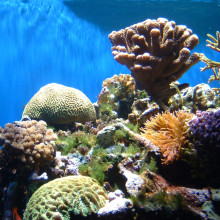
45:54 - Are corals in trouble?
Are corals in trouble?
with Jörg Wiedenmann, University of Southampton
What attracts the whale sharks to Ningaloo are the coral reefs close to shore. But corals don’t just inhabit shallow waters - in some places on Earth they live at much greater depths, although it was never clear how they survive hundreds of metres down. Now a new paper announced this week at the Royal Society Summer Science Exhibition in London, reveals the answer. From his exhibit at the Royal Society, Southampton University’s Jörg Wiedenmann is with us…
Jörg - Corals are animals and it’s a colony of animals. You have multiple polyps and they live together in various steps in coral reefs. They host little outer cells inside of their tissue and since they're attached to the rocks, they behave a little bit like plants, so they need light for their survival.
Chris - Okay, so we have an animal which has an algal cell which is a kind of plant living with it, one feeding the other. Where does the hard rocky bit of the coral come from?
Jörg - So that is secreted by the animals and they deposit it underneath it, so they sit on top of the skeleton. But the outer part now, they help potentially also with that by facilitating the position of the limestone material.
Chris - Why are people concerned that corals are in jeopardy around the world – these sort of shallow dwelling corals ? On the Barrier Reef around Australia for example, we hear a lot about that. Why?
Jörg - So, when a sea surface temperatures rise, for the synthetic algae, they become malfunctioning and then the symbiotic relationship breaks down and the outer cells are lost from the animal. As a consequence of that, their white skeleton shines through the animal tissue and that gives the coral this ghostly white appearance. This is why this phenomenon is called ‘coral bleaching’. When the corals don’t recover their outer symbionts then they usually die sooner or later.
Chris - But this is the surface dwelling corals. The ones that live deeper are not so much under threat. Is that right?
Jörg - Well, it’s not just the temperature that causes bleaching. It’s multifactorial while temperature is a major driver. Also, light plays a critical role, and also the nutrient content in the water. and so, there is a hypothesis out there that corals in deeper water may actually be more protected from this bleaching because while they might be exposed to temperature stress, the light stress certainly will be lower.
Chris - Now, if the coral relies on exposure to sunlight because those algal cells – the plant type cells that live alongside the coral creatures and feed them by capturing sunlight, and doing photosynthesis – if they depend on light to do that, surely, as you go deeper down in the water, so they're kinds of deep water corals that you’ve been studying down a hundred metres down or so, they don’t have much light down there. So, how do they get enough light for their algal cells to feed the coral?
Jörg - So, this is what the paper was about. We looked at corals that have a particular type of orange for us and pigments and we find that in corals that live in depths between 20 up to 18 metres. These pigments, they take up the blue light that is prevalent at this greater water depths, and they convert it into orange light. Interestingly, this orange light then can travel deeper into the coral colony and make sure that the symbiotic algae in deeper tissue layers can actually photosynthesise despite being exposed to relatively low light levels.
Chris - Gosh! That’s a genius. So the deep water corals are making a chemical that converts the blue light that is present in the water at depth into an orange colour that can drive the algae, make them photosynthesise.
Jörg - Exactly. That’s the mechanism.
Chris - That means that the deeper water corals are doing something quite different from the surface corals then. So, some people have suggested, well, won't it be okay with climate change and rising water temperature because the ones that live near the surface could just migrate to deeper waters. The fact that these deep dwelling corals have evolved this very special way of living would argue that actually, corals couldn’t just move deeper to get away from climate change.
Jörg - Yeah. That is one of the concerns that arises from this study because it shows how sophisticated this symbiosis is, how well adapted they are to the life in this greater depth. And also, previous studies have found that other corals, they use different types of symbiotic algae to adjust to life in greater depth or some of the others change their growth morphology, so they become very broad and form some sorts of light collectors. So, they respond in various different ways, and not all shallow water corals will be able to do the same.
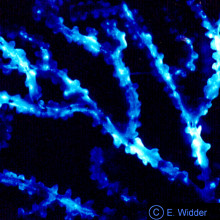
50:56 - Glow in the dark corals
Glow in the dark corals
with Joerg Wiedenmann, University of Southampton
Not content with just hearing about the amazing glow in the dark corals, we sent Tom Crawford along to Jorg Wiedenmann's exhibit at the Royal Society Summer Exhibition to check them out...
Tom - Jörg has brought me inside a very darkly lit room and he’s holding I think a UV flashlight.
Jörg - It’s blue light. So it’s 450 nanometres.
Tom - Okay, so he’s got a blue flashlight which is shining on a mini fish tank or a little puddling pool filled with about 10 centimetres of water, and there's all kinds of glowing creatures, and like rocks. Are these corals I'm looking at?
Jörg - No. what you're looking here sea anemones and they're actually our local stars, so they come from the Dorset Coast, they come from Cambridge Bay, and also from the Isle of Wight. You can see two different species here. So you have for the green tentacles here, the snakelock anemones, and here, the strawberry anemone. So the strawberry anemone would be usually red with green dots. We see here only the green dots because they contain one of this fluorescent protein pigments.
Tom - Do you have any actual corals for me to look at?
Jörg - Sure, we do, if you want to move over here. in this other tank, we have our tropical corals here. they are kept at higher temperature. You have a range of species from different parts of the world from the Great Barrier Reef, from the Caribbean, and also, from Fiji. So you can see here if we just shine the torch through the tank that there's a huge diversity of colours. We have these greens and yellow stones, and then you have various shades of red. If you also look down here, this is a typical shallow water coral and in these shallow water corals, the animal uses the fluorescent pigments to shield the symbiotic algae that live inside of the tissue from excess sunlight.
Tom - So when you say animal, the coral itself is an animal.
Jörg - Yes, the coral indeed is an animal. It belongs to the same group as the jelly fish and the sea anemones. In the case of the corals, you have many polyps that form a colony. They're attached to each other and they form a limestone skeleton on which they sit, so they're rather hard and brittle in contrast to the sea anemones or jelly fish which are quite squishy.
Tom - If a coral is an animal then, how do they feed?
Jörg - So you can see here the colonies of different shapes. In this particular colony, you have rather large polyps. One of the polyps is like 5 centimetres in diameter so they're really unusually big and you can also see that around the mouth that they are extending some tentacles. So they are behaving like a colony of sea anemones and they have this stinging cells with which they can capture prey items such as tiny crustaceans or little fish, and they feed on them.
Tom - Of course, corals are often used to demonstrate the effect – human impact on the environment and climate change it’s having because they seem to be very sensitive to changes in their environment. And beyond the fact that they're very beautiful creatures, is there a real reason why we need to make sure we look after these species?
Jörg - Yes, certainly. So you need to bear in mind, coral reefs provide a source of income for about half a billion of people in the world. Here, you have some very vivid examples. So these pigments can be used in biomedical research for example to understand how diseased cells work, you can use them to understand how cancer cells function, and the pharmaceutical industry can use them to develop tests which they can use to screen for novel drugs.
Tom - So it’s the case of taking the fluorescent pigment out of the coral. So like here, when you're shining the blue light, these things, they're really bright. They are glowing in the dark pretty and you're saying, we can take this pigment and then put it in a cell that is of interest in a human body, and then be able to track that and follow it.
Jörg - Yes, exactly that’s what we can do. Here, the pigments are encoded by the DNA so this is a very special case that you have a single pigment that is encoded by a single gene. So you can take this gene and can transfer it in a cell under study and you can use this genetic information to label proteins of interest in living cell systems.
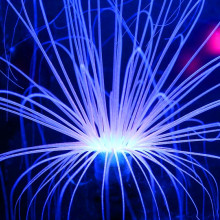
55:24 - Critter of the Week: Sea Anemone
Critter of the Week: Sea Anemone
with Sarah Lane, Plymouth University
In this week's Critter of the Week - a special version of Question of the Week for Marine Month - Georgia Mills has been treading carefully around the sea anemone...
Georgia - Name: Sea anemone. Phylum: Cnidaria. Location: sea anemones are common in tropical reefs, but they're found in every ocean in the world. Special abilities: expert harpooning and clone warfare.
Sarah Lane from Plymouth University makes the case for this contender for Critter of the Week...
Sarah - If you’ve ever been down to the sea while the tide is out, you may have noticed what appear to be little blobs of strawberry jam, covering the surfaces of exposed reefs. These blobs may appear ugly and uninteresting, but when the tide comes in, rings of vibrantly coloured tentacles appears and they are transformed into sea anemones – known for their beauty as the flowers and jewels of the sea.
Georgia - Indeed! Sea anemones even take their name from a flower but plants, they are most certainly not.
Sarah - Anemones are related to jelly fish using stinging tentacles to zap anything edible that comes past. They live in a variety of habitats from the intertidal zone down to offshore reefs, and even into the lightless abyss, and can be anywhere from millimetres to metres in diameter. Unlike their buoyant cousins, anemones are generally harmless to humans and spend most of their lives attached to rocks. But don’t let their seemingly sedentary lifestyle fool you. Anemone’s lives are far from tame. Despite having no central nervous system, sea anemones possess weapons – bead-like structures, chockfull of stinging harpoons which frame the edge of their bodies – their sole purpose, to keep other anemones away. Anemones use these harpoons when faced with a nosy neighbour, covering their opponent in flesh-eating stings in an effort to make them retreat.
Georgia - Flesh-eating harpoons, lovely! But if you think just one sounds like a handful…
Sarah - Some species of anemones even form huge colonies which act like a single army. Some of the anemones act as scouts surveying the perimeter for intruders while other, more heavily armed individuals; take the role of warriors, awaiting the scout’s signal. When two colonies meet, a no man’s land forms between them. If any anemone crosses this line, the bloodshed begins and warrior cover invaders with swades of stinging harpoons until the white flag is raised, and the other colony retreats.
Georgia - So, these are the roman army of the war to world. But as teams go, these guys take keeping it in the family to a whole new level.
Sarah - These colonies work together as one. In fact genetically, they are one. As well as possessing gnarly weapons, anemones can reproduce asexually. Meaning, that their offspring are clones and they can form entire armies of mini me-s with which to defend their home, pretty cool for a blob of jam.
Georgia - So there's much more to sea anemones than providing a home for Nemo and having a difficult name to say. Name: Sea anemone, see an enemy, sea anomany… between their flesh-eating harpoons and their vicious clone wars; they’ve won their way to Critter of the Week.










Comments
Add a comment